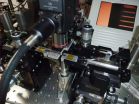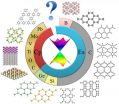The researchers wanted to find out how this discrepancy comes about. "This is of interest from an agricultural point of view, as well as for nature conservation," em-phasised Matthias Liess. That's because anybody that understands these processes better, has the possibility of slowing down the spread of resistance among our creepy crawly opponents. This wouldn't just enable us to combat them more effectively. It would also mean that less pesticides are required that are dangerous to other species. So what makes pests of all things such adaptable survival artists? The researchers had their suspicions where that was concerned. It was typically the organisms that settled in new habitats and were able to multiply rapidly. Mass reproduction of pests in this way does, however, soon lead to intensive rivalry between the creatures. It's this rivalry that could encourage the development of resistance. This is because pesticides don't just kill a proportion of the insects, but weaken those that survive as well. "That doesn't apply to resistant creatures though," explained biologist Jeremias Becker, "They now have the advantage over their weakened conspecifics and can take valuable resources away from them." That's why strong rivalry can mean that resistant pests supersede their susceptible conspecifics more quickly.
On the other hand, the situation is different for many insects, which live in the bordering fields or in the water, instead of in the crops themselves. They are part of a diverse community, in which they have other challenges to overcome too. Predators and rival species restrict multiplication and rivalry too as a result within one species. The creatures that are not resistant benefit from this according to the motto, "the en-emy of my enemy is my friend." Therefore in a diverse community, resistant crea-tures can't play off their advantage over their susceptible conspecifics so well. "This means that the gap is constantly getting bigger," explained Matthias Liess. "The pests in the crops are becoming more and more resistant to pesticides, but their neighbours in the bordering fields and in the water aren't."
UFZ researchers have tested whether this theory is correct in laboratory trials using the mosquito species Culex quinquefasciatus. These relations to the common mos-quito live in the tropics and subtropics and transmit diseases dangerous to humans and animals from avian malaria to the West Nile virus. "These creatures can be kept particularly well in the lab," explained Matthias Liess. "That's why they are often used as representatives for other mosquito species". At the beginning of the trial, there were 400 larvae of these creatures swimming in the researcher's tanks at a time. Three-quarters of them contained the genetic mate-rial of one or even two copies of a pesticide resistance gene called ace-lR. The other quarter had to manage without this genetic information and were therefore not re-sistant. The individual populations were regularly treated with the insecticide Chlorpyrifos and also confronted with different living conditions. Four of them had to share their tanks with water fleas, which gave them competition and restricted the population growth. With four others, the researchers removed ten to twenty percent of the larvae twice a week, in order to simulate the influence of predators. The surviving mosquitoes in this population lived plentifully without having to grapple with other organisms. In the final four populations, the insects were allowed to multiply uninterrupted and soon faced intense rivalry. The researchers then observed how the frequency of resistance genes changed over six generations of mosquitoes - a process, biologists refer to as "microevolution".
As a result, the quickest transformation was experienced by the populations without predation and interspecific competition species. The proportion of mosquitoes with a resistance gene rose from 75 to 95 percent over the course of the trial. "In these populations, creatures only had to prevail against competition from their own ranks," explained Matthias Liess. Small differences in genetic material can bring crucial ad-vantages, especially when resources are low. That's why rivalry among conspecifics accelerates microevolution. On the other hand, the situation looks very different when competing species like water fleas or predators such as researchers catching larvae come into play. In both cases, the resistance gene spread significantly more slowly in the populations under the influence of pesticide. However, if there was no insecticide in the water, the same mechanisms ensured that the populations quickly lost their resistance gene again without enemy species. If they weren't confronted with the poisonous preparation at all, this genetic trait would ultimately bring them no benefits, only disadvantages, as resistance comes at a price. That means resistant creatures must invest in additional enzymes, for example, which are able to break down the pesticide. The energy they require for this is then lacking for other tasks. For example, it often leads to resistant creatures experiencing poorer growth. When there's stronger rivalry, only 40 instead of 75 percent percent of mosquitoes hold the resistance gene after six generations. However, water fleas and predators delayed this development too. Additional challenges like these really do seem to slow down microevolution.
The scientists anticipate that these effects constitute a fundamental principle and therefore apply to all habitats and species. "This could possibly result in new ap-proaches towards pest control being deduced," said Matthias Liess. This means that the increase in biodiversity with competitors and predators of harmful organisms will reduce the development of resistance. If harmful organisms try to penetrate fields, they will therefore be easier to tackle using lower levels of pesticide. "Whether this will work in practice, however, must be investigated first," emphasised Matthias Liess. However, there is one thing he does not doubt: as well as bringing wide eco-logical advantages, species diversity also makes easier pest control.
INFORMATION:
Publication:
Becker JM, Liess M. 2015
Biotic interactions govern genetic adaptation to toxicants. Proc. R. Soc. B 20150071.
http://rspb.royalsocietypublishing.org/content/282/1806/20150071
Further information:
Helmholtz Centre for Environmental Research (UFZ)
Prof. Dr. Matthias Liess or Jeremias Becker
Phone: 0151/52739036 or +49(0)341-235-1494
http://www.ufz.de/index.php?en=3714
http://www.ufz.de/index.php?en=18947
or via
Tilo Arnhold, Susanne Hufe (UFZ press office)
Phone: +49 (0)341-235-1635, -1630
http://www.ufz.de/index.php?en=640
In the Helmholtz Centre for Environmental Research (UFZ), scientists conduct research into the causes and consequences of far-reaching environmental changes. Their areas of study cover water resources, biodiversity, the consequences of climate change and possible adaptation strategies, environmental technologies and biotech-nologies, bio-energy, the effects of chemicals in the environment and the way they influence health, modelling and social-scientific issues. Its guiding principle: Our re-search contributes to the sustainable use of natural resources and helps to provide long-term protection for these vital assets in the face of global change. The UFZ em-ploys more than 1,100 staff at its sites in Leipzig, Halle and Magdeburg. It is funded by the federal government, Saxony and Saxony-Anhalt. http://www.ufz.de/
The Helmholtz Association contributes to solving major and urgent issues in socie-ty, science and industry through scientific excellence in six research areas: Energy, earth and environment, health, key technologies, structure of matter as well as avia-tion, aerospace and transportation. The Helmholtz Association is the largest scientific organisation in Germany, with 35,000 employees in 18 research centres and an an-nual budget of around €3.8 billion. Its work is carried out in the tradition of the great natural scientist Hermann von Helmholtz (1821-1894). http://www.helmholtz.de/


